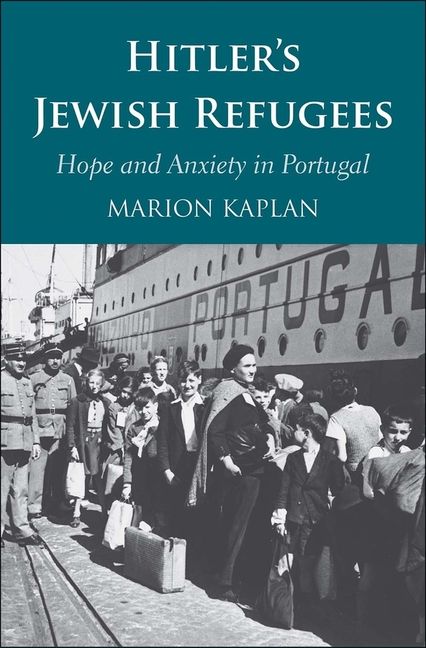
Within Holocaust Studies fleeing and survival are today the subjects of a growing scholarship, which analyses Jewish life in exile in precarious sanctuaries in Europe, the Americas, the Soviet Union, North Africa and Asia. This literature acknowledges that even the experiences of “the lucky ones” who abruptly left their home-countries to became refugees, “formed part of the history of the Holocaust” (p. 231). Marion Kaplan’s study of Jewish refugees in Portugal during the Second World War sheds light on an under-research chapter of the Holocaust and, at the same time, sets the stage for a fresh and innovative perspective to investigate the topic of Jewish refugees.
In Hitler’s Jewish Refugees Kaplan turns to the use of space as an analytical category for her investigation into the case of Jewish refugees in neutral Portugal. In her analysis, the author draws on the methodological approach introduced by Holocaust geographers, who suggest moving beyond the question of “where,” to focus instead “on the spaces and places that people created, occupied, passed through and endured.”1 If this is today a consolidated analytical category in Holocaust historiography, the focus on emotions and refugees’ voices represent the most fascinating aspect of this study. Digging into a wide array of sources, but centering the analysis especially around ego-documents (refugees’ letters, diaries, memoires), Kaplan disentangles the multi-layered plot of Jews’ liminal experience in Portugal.
The book contextualizes the Jews’ stay in Salazar’s Portugal in the framework of the refugee crisis generated by National Socialism and the failures of national governments and intergovernmental agencies to provide an efficient response to this mass escape. In contrast, it depicts the prompt reaction and often lifesaving commitment of the Jewish aid organizations, local and international, involved in assisting the refugees in their odysseys. However, as highlighted in the subtitle of the book—Hope and Anxiety in Portugal—what the author puts into the foreground are the “refugees’ terrifying flights and their strategies of physical and emotional survival” (p. 3).
In the introduction, the author presents her work as an “emotional history of fleeing” (p. 2). The seven chapters making up the book follow the chronology and the geographical trajectories of the Jewish refugees from Central and Eastern Europe to Portugal, and beyond. Each chapter begins with an epigraph of today refugees’ words, connecting refugees then and now through the focus on the emotions they were confronted with while fleeing.
Chapter one details the different waves of refugees reaching Portugal in the attempt to leave Europe: several hundreds arrived sporadically between 1933 and 1939; probably more than 70,000 fled after the fall of France in 1940; and another 10,000 appeared when Germany invaded all of France and started to deport Jews in 1942. As the war broke out and the tensions and persecutions intensified, the need to escape became more desperate and journeys more complicated and hazardous. Refugees were confronted with long lines at consulates, crowded roads, uncomfortable travels and walks, border crossings which exposed them to unpredictable dangers and turned into the “ ‘central emotional experiences’ of flight” (p. 38). Kaplan’s analysis of the refugees’ accounts explains that states’ policy and bureaucracy are not the only factors influencing the outcome of the flight. Health and physical stamina, luck, familial and communal networks, the availability of money and support, courage and resilience, casual acquaintances and generosity could simplify the arrival in Portugal.
With Chapters two and three the narrative moves from the “the desperate need to flee” to “the endless agony of waiting” (p. 64) in Portugal, which emerges as a liminal space, evoking contrasting feelings of anxieties and relief, frustrations and hopes, comfort and distress. Salazar’s Portugal, with its changing and ambivalent politics, proved a precarious sanctuary for Jews. Officially, it offered a temporary shelter for people in transit, but as the destination countries slowed down the issuance of entry visas, the Jewish refugees’ situation in Portugal worsened. The obstacles in getting ship passages overseas and the necessary documents to leave forced most of them to stay in a country unwilling to host them indefinitely. These chapters offer a nuanced picture of Jewish refugees’ life in Portugal. While institutional sources document the ambivalent attitude of Salazar and the efforts of the Jewish aid organizations in helping this flow of disoriented refugees, personal accounts are used to show how Jewish refugees dreaded Portuguese authorities and police, but shared positive memories of their encounters with the local population.
The following three chapters (4-5-6) focus on the array of Jewish refugees’ emotional responses to their forced stay in Portugal. Waiting to find a way out from Portugal meant being confronted with a demoralizing routine, while mourning what had been left behind, and shaping new relationships. Jewish refugees faced daunting obstacles to secure food and accommodation and devoted all their physical and emotional efforts to gather the necessary documents to leave the country as soon as possible, threatened by imprisonment or forced residency in case of failure. Anxiety, frustration, and anguish—dominant features of the memoires and accounts on “the reality of waiting”—were amplified by the uncertainty about their future and the difficulties to get news from the loved ones under the Nazis. In the desperate attempt to find some consolation and relief, cafés became “temporary and contingent ‘Jewish spaces’,” serving as important hubs of information and confrontation among people going through similar losses and needs. The shortage of ships further exasperated their waiting. And, as shown in the last chapter (7) before the conclusion, even when they succeeded in obtaining a visa and boarding a ship, refugees continued to feel insecurity because of the ocean crossing and the pain of leaving their relatives and friends behind.
Throughout the book, Kaplan pays particular attention to two factors which crucially influenced the Jewish refugees’ experience in traversing and enduring diverse sites of anxiety: age and gender.
Kaplan focuses especially on the “emotional dissonance” (p. 127) between older refugees experiencing an identity crisis and disempowerment and the younger ones who lived their displacement in Portugal as a time to explore and look forward. Whereas the youths recalled it as “a good time,” the loss of home, homeland and status generated terrible worries in the adults and profoundly transformed their sense of self. Moreover, the author reflects on how gender expectations influenced men’s self-perception when facing the lack of work, possessions, institutional and familial acknowledgment. Gender roles, however, which fluctuated significantly before fleeing (especially when women intervened with governments officials to liberate men from concentration camps), flattened during Jewish refugees’ time in Portugal. Instead, cultural differences in gender roles caused mutual misunderstanding between the Portuguese and the refugees, for instance when refugee women wore unusual beach attire or appeared in typically “male spaces” (p. 95), such as cafés.
This inspiring book encourages historians of the Holocaust to rethink Jewish refugees between the 1930s and the aftermath of the Second World War through a more inclusive perspective on their voices. Drawing extensively on ego-documents to show how feelings shaped refugees’ decisions and experiences, Kaplan acknowledges the refugees as historical subjects and reminds us of the importance to consider them first of all as individuals, even today.
1 Alberto Giordano, Anne Kelly Knowles, and Tim Cole, eds., Geographies of the Holocaust (Bloomington, IN: Indiana University Press, 2014), 2.
